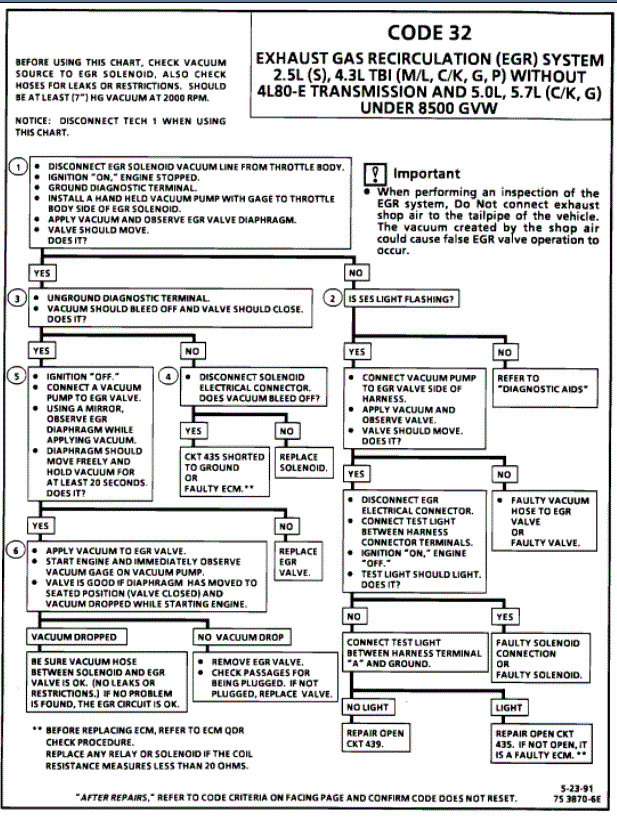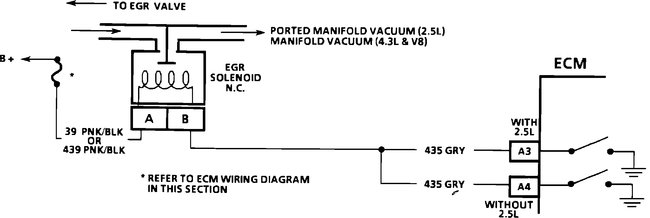Hi,
It could be a few different things. Do me a favor. Take a look through these diagnostics for the code and see if it has things you feel comfortable doing. The attached pics correlate with the directions. Actually, pic 1 is the primary set of directions.
__________________________________
1993 Chevy Truck K 1500 Truck 4WD V8-350 5.7L
Under 8500 GVW
Vehicle ALL Diagnostic Trouble Codes ( DTC ) Testing and Inspection Manufacturer Code Charts DTC 32 Powertrain Controls - ECM/PCM Without Electronic Transmission Under 8500 GVW
UNDER 8500 GVW
Exhaust Gas Recirculation System Circuit Code 32
pic 1
Exhaust Gas Recirculation System Circuit
pic 2
Circuit Description:
The ECM operates a solenoid to control the exhaust gas recirculation (EGR) valve. This solenoid is normally closed. By providing a ground path, the ECM energizes the solenoid which then allows vacuum to pass to the EGR valve.
The ECM monitors EGR effectiveness by de-energizing the EGR control solenoid, thereby, shutting "OFF" vacuum to the EGR valve diaphragm. With the EGR valve closed, and 02 sensor fluctuating normally, fuel integrator counts will be greater than they were during normal EGR operation. If the change is not within the calibrated window, a Code 32 will be set.
The ECM will check EGR operation when:
Vehicle speed is above 45 mph.
Engine vacuum is between 15 and 60 kPa.
Throttle angle between 6 and 30%.
No change in throttle position while test is being run, max. 4%.
EGR on threshold 98%.
Test Description:
Number(s) below refer to circled number(s) on the diagnostic chart.
1. By grounding the diagnostic terminal, the EGR solenoid should be energized and allow vacuum to be applied to the EGR valve and the vacuum should hold.
2. The "Service Engine Soon" light should also flash while the diagnostic terminal is grounded. If the light does not flash, this may indicate that the "Quad-Driver" has been damaged by low resistance in TCC circuit.
3. When the diagnostic terminal is ungrounded, the vacuum to the EGR valve should bleed off through a vent in the solenoid and the valve should close. The gage may or may not bleed off but this does not indicate a problem.
4. This test will determine if the electrical control part of the system is at fault or if the connector or solenoid is at fault.
5. This system uses a negative backpressure valve which should hold vacuum with engine "OFF."
6. When engine is started, exhaust backpressure should cause vacuum to bleed off and valve should fully close.
Diagnostic Aids:
Before replacing ECM, use an ohmmeter and check the resistance of each ECM controlled relay and solenoid coil. For example: TCC, etc, See: Computers and Control Systems > Component Tests and General Diagnostics > ECM QDR Check Procedure (Without 4L80-E Transmission) Refer to "ECM Wiring Diagram" for coil terminal ID of solenoid(s) and relay(s) to be checked. Replace any solenoid where resistance measures less than 20 ohms.
______________________________
Let me know if that helps.
Take care,
Joe
Images (Click to make bigger)
Thursday, February 18th, 2021 AT 5:36 PM




